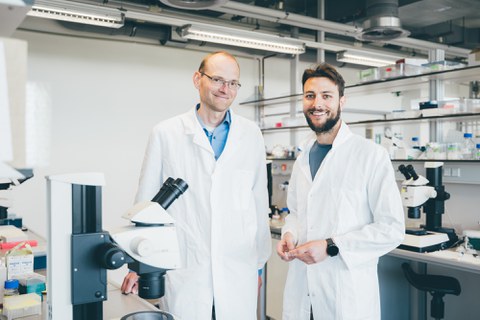Apr 30, 2025
The Sleep Switch: How One Brain Signal Turns Sleep On and Off

Prof. Henrik Bringmann and Lorenzo Rossi.
People spend about a third of their life asleep. Yet, surprisingly little is known about how our brains control falling asleep and waking up. Now, researchers led by Prof. Henrik Bringmann at the Biotechnology Center (BIOTEC) of TUD Dresden University of Technology discovered another piece of this puzzle. The team showed that a single brain signal acts like a biological switch - both triggering sleep and ending it. Their findings, published in the journal Current Biology, were made possible by studying a tiny roundworm C. elegans, a powerful model organism in biology.
“It is really important to be able to fall asleep, but just as important to wake up too!,” says Prof. Bringmann, research group leader at BIOTEC who led the study. “We know that falling asleep and waking up is controlled by a special set of brain cells, called sleep neurons. However, we don’t know how exactly they control the downstream molecular pathways to make us fall asleep and wake up again.”
The Bringmann group turned to C. elegans, a tiny roundworm to answer these questions. In contrast to humans, who have thousands of sleep neurons that control sleep, C. elegans needs just one neuron to do this job. This simplicity makes it a perfect model organism to study the principal molecular pathways controlling sleep.
This research sheds light on one of the fundamental questions in biology: how organisms regulate sleep and wakefulness. By understanding the fundamental molecular machinery behind sleep, researchers can better understand sleep disorders such as narcolepsy and insomnia that that have a major impact on quality of life. The findings also add to the growing body of evidence that even simple model organisms can reveal fundamental mechanisms that govern life.
One Molecule, Two Jobs
The team focused on a chemical messenger called FLP-11. When a sleep neuron activates, it releases FLP-11. Such chemical messengers work like molecular “notes” that are passed between brain cells to deliver different commands. “We knew that FLP-11 is essential to sleep but we didn’t know what message it delivers and to whom,” explains Prof. Bringmann.
Through genetic screening, the researchers identified a key receptor, called DMSR-1, that FLP-11 binds to deliver its message. If this receptor was missing from the brain, researchers observed that the worms slept significantly less. DMSR-1 turned out to be present in different types of neurons. Depending on which neuron received the message, the results were dramatically different.
“We discovered that FLP-11 activates DMSR-1 receptors in two completely different types of neurons,” says Lorenzo Rossi, a PhD student who conducted the experiments in the lab of Prof. Bringmann.
“We found the receptor present in neurons that promote wakefulness. When activated by FLP-11, the receptor turns off the wakefulness neurons. This, in turn, helps the worm fall asleep. On the other hand, the receptor is also present in the sleep neuron itself. Here, it also turns it off, which ultimately wakes the animal back up,” explains Lorenzo Rossi.
In other words, the same chemical that puts the worm to sleep also helps wake it up again, simply by targeting different cells in the brain. “It is an efficient mechanism that controls the start of sleep while also keeping its duration in check,” adds Prof. Bringmann.
A Universal Principle?
“Unlike humans, C. elegans have much shorter sleep phases that last only around 20 minutes. However, sleep is such a fundamental biological process that many molecules and mechanisms involved in sleep are shared across species,” says Prof. Bringmann. “We don’t yet know if the same sleep switch exists in humans, but it provides a promising clue in the search for mechanisms that control sleep in our species.”
Original Publication
Lorenzo Rossi, Kenneth Amoako, Inka Busack, Luca Golinelli, Amy Courtney, Judith Besseling, William Schafer, Isabel Beets, Henrik Bringmann: FLP-11 RFamide neuropeptides induce and self-inhibit sleep through the Gi/o protein-coupled receptor DMSR-1. Current Biology (May 2025)
Link: https://doi.org/10.1016/j.cub.2025.03.039
About the Biotechnology Center (BIOTEC)
The Biotechnology Center (BIOTEC) was founded in 2000 as a central scientific unit of the TU Dresden with the goal of combining modern approaches in molecular and cell biology with the traditionally strong engineering in Dresden. Since 2016, the BIOTEC is part of the central scientific unit “Center for Molecular and Cellular Bioengineering” (CMCB) of the TU Dresden. The BIOTEC is fostering developments in research and teaching within the Molecular Bioengineering research field and combines approaches in cell biology, biophysics and bioinformatics. It plays a central role within the research priority area Health Sciences, Biomedicine and Bioengineering of the TU Dresden.
www.tu-dresden.de/cmcb/biotec
www.tu-dresden.de/cmcb
Photos:
Media Contact:
Dr. Magdalena Gonciarz
Public Relations Officer
Tel.: +49 (0) 351 458 82065
E-mail:
Scientific Contact:
Prof. Henrik Bringmann
Biotechnology Center (BIOTEC) of TU Dresden
Tel: +49 (0) 351 463 40330
Email:
Webpage: https://tud.link/uxep
